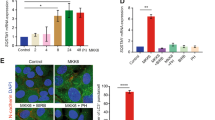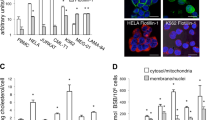Abstract
Treatment of human promyeloleukemic HL-60 cells with the experimental antileukemic drug ajoene induces the activation of the mitogen-activated protein kinases (MAPKs) c-Jun NH2-terminal kinase (JNK), p38 and extracellular signal-regulated kinases (ERK) 1/2 as well as the survival kinase Akt. JNK activation occurred in HL-60/neo, HL-60/bcl-xL, and in HL-60 cells pretreated with the pan-caspase inhibitor zVAD-fmk, indicating that JNK activation is not dependent on ajoene-induced mitochondria perturbation and subsequent caspase activation. Cells overexpressing a dominant-negative JNK showed no altered sensitivity towards ajoene suggesting that the activation of JNK is not necessary for ajoene-induced cell death. Inhibition of p38 MAPK by SB 203580 had no influence on ajoene-mediated apoptosis. In contrast, inhibition of ERK1/2 vastly enhanced ajoene-induced cell death. The survival kinase Akt, in contrast, did not participate in ajoene-induced death signaling as shown by the use of the phosphatidylinositol-3-kinase inhibitor wortmannin. Thus in contrast to the previous findings regarding stress-induced cell death, ajoene-mediated activation of JNK and p38 has no impact on ajoene-induced apoptosis in HL-60 cells. Blockade of ERK1/2 but not Akt pathways leads to sensitization of cells against ajoene-mediated apoptosis supporting the view that inhibition of ERK1/2 is a valuable strategy to increase the sensitivity of promyeloleukemic cells towards ajoene.
This is a preview of subscription content, access via your institution
Access options
Subscribe to this journal
Receive 50 print issues and online access
$259.00 per year
only $5.18 per issue
Buy this article
- Purchase on Springer Link
- Instant access to full article PDF
Prices may be subject to local taxes which are calculated during checkout






Similar content being viewed by others
References
Agarwal KC . (1996). Med. Res. Rev., 16, 111–124.
Bamford M, Walkinshaw G and Brown R . (2000). Exp. Cell Res., 256, 1–11.
Bennett BB, Sasaki DT, Brion WM, Eoin COL, Sakata ST, Xu W, Leisten JC, Motiwala A, Pierce S, Satoh Y, Bhagwat SS, Manning AM and Anderson DW . (2001). Proc. Natl. Acad. Sci. USA, 98, 13681–13686.
Bradford MM . (1976). Anal. Biochem., 72, 248–254.
Butterfield L, Storey B, Maas L and Heasley LE . (1997). J. Biol. Chem., 272, 10110–10116.
Chang L and Karin M . (2001). Nature, 410, 37–40.
Chen YR, Wang W, Kong AN and Tan TH . (1998). J. Biol. Chem., 273, 1769–1775.
Chen YR, Wang X, Templeton D, Davis RJ and Tan TH . (1996). J. Biol. Chem., 271, 31929–31936.
Chen YR, Zhou G and Tan TH . (1999). Mol. Pharmacol., 56, 1271–1279.
Datta SR, Brunet A and Greenberg ME . (1999). Genes Dev., 13, 2905–2927.
Datta SR, Dudek H, Tao X, Masters S, Fu H, Gotoh Y and Greenberg ME . (1997). Cell, 91, 231–241.
del Peso L, Gonzalez-Garcia M, Page C, Herrera R and Nunez G . (1997). Science, 278, 687–689.
Dirsch VM, Antlsperger DSM, Hentze H and Vollmar AM . (2002). Leukemia, 16, 74–83.
Dirsch VM, Gerbes AL and Vollmar AM . (1998). Mol. Pharmacol., 53, 402–407.
Dirsch VM, Stuppner H and Vollmar AM . (2001). Cancer Res., 61, 5817–5823.
Eichhorst ST, Muller M, Li-Weber M, Schulze-Bergkamen H, Angel P and Krammer PH . (2000). Mol. Cell Biol., 20, 7826–7837.
Eilers A, Whitfield J, Shah B, Spadoni C, Desmond H and Ham J . (2001). J. Neurochem., 76, 1439–1454.
Galan A, Garcia-Bermejo ML, Troyano A, Vilaboa NE, de Blas E, Kazanietz MG and Aller P . (2000). J. Biol. Chem., 275, 11418–11424.
Gupta K, Kshirsagar S, Li W, Gui L, Ramakrishnan S, Gupta P, Law PY and Hebbel RP . (1999). Exp. Cell Res., 247, 495–504.
Hancock JT, Desikan R and Neill SJ . (2001). Biochem. Soc. Trans., 29, 345–350.
Herr I and Debatin KM . (2001). Blood, 98, 2603–2614.
Ibrado AM, Huang Y, Fang G, Liu L and Bhalla K . (1996). Cancer Res., 56, 4743–4748.
Jarvis WD, Johnson CR, Fornari FA, Park JS, Dent P and Grant S . (1999). J. Pharmacol. Exp. Ther., 290, 1384–1392.
Kennedy SG, Kandel ES, Cross TK and Hay N . (1999). Mol. Cell Biol., 19, 5800–5810.
Kummer JL, Rao PK and Heidenreich KA . (1997). J. Biol. Chem., 272, 20490–20494.
Lali FV, Hunt AE, Turner SJ and Foxwell BM . (2000). J. Biol. Chem., 275, 7395–7402.
MacFarlane M, Cohen GM and Dickens M . (2000). Biochem. J., 348, 93–101.
Mackay K and Mochly-Rosen D . (1999). J. Biol. Chem., 274, 6272–6279.
MacKeigan JP, Collins TS and Ting JP . (2000). J. Biol. Chem., 275, 38953–38956.
Mandlekar S, Yu R, Tan TH and Kong AN . (2000). Cancer Res., 60, 5995–6000.
Nicoletti I, Migliorati G, Pagliacci MC, Grignani F and Riccardi C . (1991). J. Immunol. Methods, 139, 271–279.
Oh-hashi K, Maruyama W, Yi H, Takahashi T, Naoi M and Isobe K . (1999). Biochem. Biophys. Res. Commun., 263, 504–509.
Sanchez-Perez I, Martinez-Gomariz M, Williams D, Keyse SM and Perona R . (2000). Oncogene, 19, 5142–5152.
Shiah SG, Chuang SE, Chau YP, Shen SC and Kuo ML . (1999). Cancer Res., 59, 391–398.
Shiah SG, Chuang SE and Kuo ML . (2001). Mol. Pharmacol., 59, 254–262.
Tang D, Okada H, Ruland J, Liu L, Stambolic V, Mak TW and Ingram AJ . (2001). J. Biol. Chem., 276, 30461–30466.
Tournier C, Hess P, Yang DD, Xu J, Turner TK, Nimnual A, Bar-Sagi D, Jones SN, Flavell RA and Davis RJ . (2000). Science, 288, 870–874.
Wang TH, Wang HS and Soong YK . (2000). Cancer, 88, 2619–2628.
Watabe M, Kakeya H and Osada H . (1999). Oncogene, 18, 5211–5220.
Xia Z, Dickens M, Raingeaud J, Davis RJ and Greenberg ME . (1995). Science, 270, 1326–1331.
Yen A, Robertson MS, Varvayanis S and Lee AT . (1998). Cancer Res., 58, 3163–3172.
Zanke BW, Boudreau K, Rubie E, Winnett E, Tibbles LA, Zon L, Kyriakis J, Liu FF and Woodgett JR . (1996). Curr. Biol., 6, 606–613.
Zechner D, Craig R, Hanford DS, McDonough PM, Sabbadini RA and Glembotski CC . (1998). J. Biol. Chem., 273, 8232–8239.
Zhuang S, Demirs JT and Kochevar IE . (2000). J. Biol. Chem., 275, 25939–25948.
Acknowledgements
We thank S Eichhorst (Department of Medicine II, Klinikum Grosshadern, University of Munich) for critically reading the manuscript. This work was supported by the Deutsche Forschungsgemeinschaft (SFB 369).
Author information
Authors and Affiliations
Corresponding author
Rights and permissions
About this article
Cite this article
Antlsperger, D., Dirsch, V., Ferreira, D. et al. Ajoene-induced cell death in human promyeloleukemic cells does not require JNK but is amplified by the inhibition of ERK. Oncogene 22, 582–589 (2003). https://doi.org/10.1038/sj.onc.1206161
Received:
Revised:
Accepted:
Published:
Issue Date:
DOI: https://doi.org/10.1038/sj.onc.1206161
Keywords
This article is cited by
-
Unveiling the effect of dietary essential oils supplementation in Sparus aurata gills and its efficiency against the infestation by Sparicotyle chrysophrii
Scientific Reports (2020)
-
Compounds from Allium species with cytotoxic and antimicrobial activity
Phytochemistry Reviews (2014)
-
Potential role of organic sulfur compounds from Allium species in cancer prevention and therapy
Phytochemistry Reviews (2009)
-
The role of p38 MAPK activation in auranofin‐induced apoptosis of human promyelocytic leukaemia HL‐60 cells
British Journal of Pharmacology (2005)
-
Garlic arrests MDA-MB-435 cancer cells in mitosis, phosphorylates the proapoptotic BH3-only protein BimEL and induces apoptosis
British Journal of Cancer (2005)



